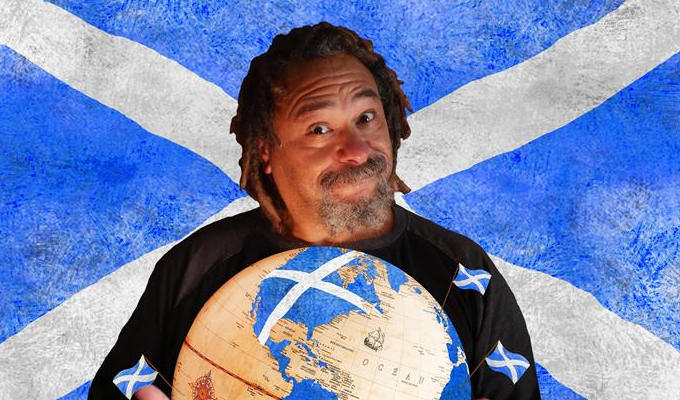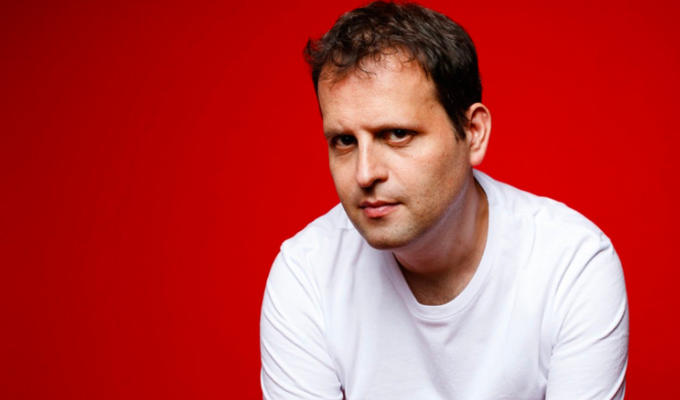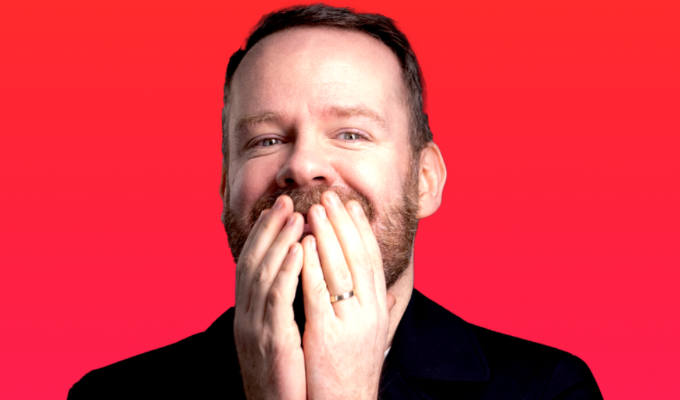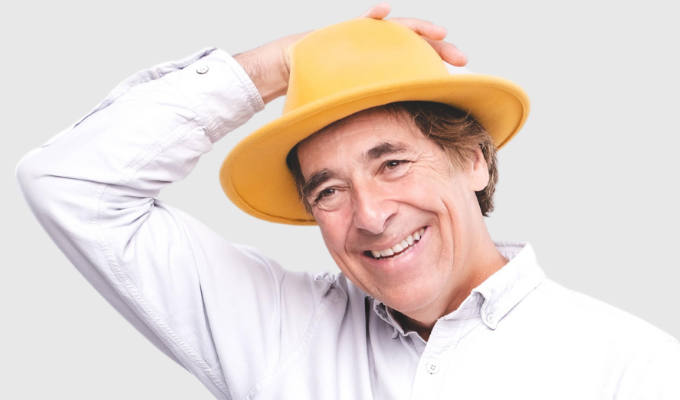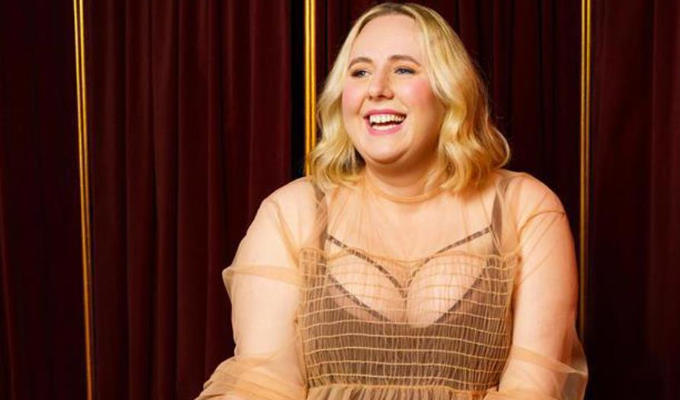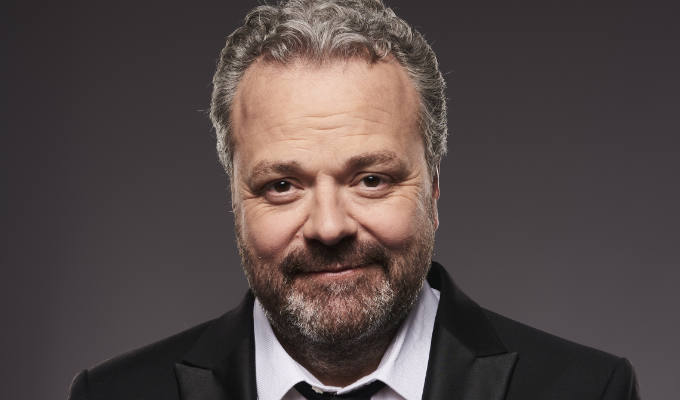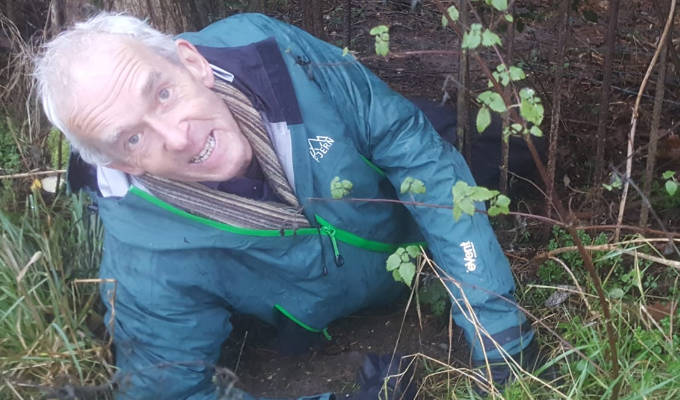
Less is more: in praise of innuendo and allusion
Kim Wells is losing his tolerance for graphic comedy
Kim Wells reflects on how the relaxation of censorship and the diktats of ‘good taste’ has allowed comedy to become more explicit since the days he ran Earth Exchange Cabaret in the 1980s; and how his own tolerance of graphic content has declined with age, now finding himself preferring the more subtle innuendo-based approach of comics like George Formby.
About nine years ago I accompanied a friend to see a performance of The Ruby Darlings, a female burlesque and comedy duo, in a hired church hall in Crouch End. My friend had been invited by a friend who was the mother of one of the duo. The duos’ parents. who were in their 60s, had invited all their friends, mostly of a similar age. The two were very talented singers who sang graphic songs about formerly taboo topics like masturbation, pubic hair and menstruation as well as doing burlesque, dressed (to varying degrees) in the standard paraphernalia of feathered fans, sequins and nipple tassels.
When younger I may well have found their explicit treatments of these topics mildly amusing but in my mid-60s I found them embarrassingly unfunny - and, yes, though this is hard for a liberal, erstwhile ‘alternative’ comic to admit, tasteless to say the very least. Like Ben Elton, when he castigated Benny Hill in 1987 for contributing to the situation that ‘women can’t walk safely in the park anymore’, I was unearthing my inner ‘Mary Whitehouse’.
The other 60-plus-year-old members of the audience seemed to be making a good stab at laughing (and hiding any embarrassment). This was despite many having known the two performers through their own children when presumably they were sweet, innocent young girls.
Now they made a point of trying to be anything but innocent. But they still retained an incongruous element of childlike cuteness that made their explicit material seem all the more jarring and embarrassing. Normally comedy thrives on incongruity and anomaly but here, the juxtaposition of cuteness and vulgarity seemed disconcertingly inappropriate rather than comic.
I admit I enjoyed the burlesque except I felt uneasy about ogling young women nearly 40 years my junior. It seemed strange they were so relaxed about stripping in front of their parents and parents’ friends – and, even stranger, that their own parents, seemed relaxed too. But this was Crouch End.
They did one particularly explicit song entitled Say No To Anal.. This lamented the tendency of their male contemporaries – inspired by their avid consumption of online pornography – to put pressure on their female partners to engage in anal sex. A pressing social issue no doubt, but not one I could relate to personally.
Far from being a must-have notch on the bedpost, this practice as a heterosexual option didn’t seem to have been invented when I was young. The best the fledgling pornographic industry could offer in 1963 was Eves On Skies, a naturist documentary featuring nude cross-country skiing, snow-to-skin snowball fights and, most memorably, the construction of an igloo using large chunks of ice carefully positioned to hide the frolickers’ pubic parts.
Though witty, the song was far too explicit for someone of my increasingly delicate disposition. The chorus began: ‘It’s for number two, it’s not for pleasing you …' What made this song particularly mortifying was that the whole audience were asked to stand up and sing the very explicit words, written on placards. Everyone stood up dutifully and sang (or mouthed) the words.
Despite my showbiz ethic of solidarity, I couldn’t remain standing. I sat down along with my companion, the only people in the audience to do so. I began to see that Mary Whitehouse might have had a point. Some areas of the human anatomy are best left unexplored, at least in comedy. Performing and watching live comedy does demand a strong masochistic streak - which I must have had to perform comedy - but this went way beyond anything I could endure.
The fact I couldn’t bring myself to join in only turned the screw on my embarrassment. I have always felt laughter is such a hallowed thing that it’s churlish and even sacrilegious not to laugh too. There is also the risk of being called a spoilsport or party pooper, especially in the company of those hearty, ‘life-and-soul-of-the party’ types who take great delight in jeering at and guilt-tripping those ‘miserable bastards’ who fail to live up to their high standards of jocularity. But, in the ‘number two’ song, I just couldn’t or rather wouldn’t laugh. I just wanted the ground to open up and swallow me.
This, for me, was also a salutary experience. Inspired by the ethos of alternative comedy and my extensive experience of psychotherapy - both of which valued authenticity and openness – I had sometimes been far too explicit in my Earth Exchange days. Now, on the receiving end, I was getting my comeuppance.
According to anthropologist, Mary Douglas, ‘dirt’ – the ‘impure’, ‘unclean’ or ‘obscene’ – is what is regarded in any particular society as matter out of place. In the Say No To Anal routine, the matter in question seemed to me definitely out of place. You could equally say that I was out of place. I shouldn’t have been there. I was too old, too traditionally male, too squeamish, and – it would seem – too prim and proper.
Since my youth I had developed, to my cost, a sense of decorum and seemliness. But how was I to know the daughter of my friend’s friend would be showcasing such intimate stuff in such an inescapably graphic way - in front of her parents?
I dread to think how I would have reacted to Marjolein Robertson’s material. Three men fainted – and loads more people walked out - at her recent Edinburgh Fringe show over her graphic description of her episode of uterine haemorrhaging.
With my little ukulele in my hand
For me, comedy thrives on suggestion and allusion, on innuendos, double entendres, euphemisms and pointed omissions. In other words, on winks, hints and nudges. With the occasional exception, less is more (and conversely more is less). When comics are driven to explore the nether regions in their routines, I much prefer George Formby’s relatively subtle innuendo-based approach to the in-your-face one of Roy ‘Chubby’ Brown.
Formby excelled at the art of the innuendo. It is the sheer ingenuity and cheeky innocence of his innuendos that make his songs so funny and endearing. In his now politically suspect ode to mixed bathing, Swimming With The Wimmin’, for instance, he's taken aback when he discovers: ‘What I took to be her face, turned out to be another place, when I went swimming with the wimmin'. He makes an oblique reference to his own unmentionables – and possibly more – in the line: ‘Bobbing up and down in the water, it comes just below my Mason–Dixon Line’. In his voyeuristic anthem, When I’m Cleaning Windows, he observes: ‘Pyjamas lying side by side, ladies’ underwear I’ve spied, I’ve even seen what goes inside, when I’m cleaning windows.’
For his time, Formby could get very near ‘the line’ if not overstep it. For instance, ‘She said: "Your love turns me dizzy, come on big boy get busy", But I kept my little ukulele in my hand, yes sir’. One doesn’t need to have read Freud to see the sexual symbolism of an ukulele in this context but Formby leaves his audience with a choice in the way they interpret it.
The expression ‘big boy’ has a particular connotation in bedroom parlance. Yet, in both cases, it is possible to go with the literal, innocent interpretation. The Say No To Anal routine gives one no choice. Mind you, the ukulele song ends with his newborn baby holding ‘his little ukulele in his hand’ leaving little doubt as to what Formby meant when he refers to his own ‘ukulele’. But what a delicate way to refer to ‘it’.
Setting aside any reservations about Formby’s voyeuristic (and, from a modern standpoint, highly sexist) proclivities, innuendos in my opinion generate more resonant and satisfying laughs. They allow a creative role for the audience’s imagination in that they have to work harder to understand the gags and fill in the gaps.
More explicit humour relies a lot on shocking the audience (rather than on allusion and confounding expectations) and not surprisingly usually appeals more to a younger audience. The laughter is based primarily on the fact that a taboo subject has been audaciously aired in public rather than the wit and perceptive wisdom characteristic of a more sophisticated gag.
The implicit nature of an innuendo softens or tones down the smutty content. There’s a big difference between bluntly spelling it out and implying it – especially if coarse language is used. The innuendo’s non-specific, ambiguous and open-ended aspects allow the audience to make what they will of it. Those of a more refined or delicate disposition can choose to edit out or tone down bits they find unpalatable.
Others with more salacious proclivities may let their imaginations run wild creating graphic images way beyond what the comic intended or envisaged. In Formby’s ‘Swimmin With The Wimmin’, the line ‘What I took to be her face’ is clearly a reference to the lower regions but what exactly is being peered at is not spelled out. I can think of several images along a spectrum of smut, some considerably more pornographic than others.
Ken Dodd could also be ingenious in finding subtle ways to refer to erogenous areas of the body. One innuendo I thought particularly tasteful yet evocative was: ‘You know there are 206 bones in the human body but there's not a single one in the interesting bits’. This is all the funnier for being a very original way of approaching a very unoriginal subject. You think you’re getting an edifying lesson on anatomy but then comes the bathetic descent into sex.
Comedy and striptease: a symbiotic relationship
Though they may seem strange bedfellows, comedy and striptease have traditionally enjoyed a symbiotic relationship (one nobly continued by The Ruby Darlings). In the Windmill Theatre (1931 – 1964) in Soho, comics like Tony Hancock, Spike Milligan and Tommy Cooper alternated with striptease artists.
Before that, comedy and striptease coexisted for several decades in the burlesque variety theatre tradition, particularly in the USA. The original Comedy Store and the Comic Strip in the early 1980s took place in striptease venues. Striptease has certainly played an important role in subsidising live comedy. I am surprised the last Tory government didn’t propose it as a cost-cutting alternative to the Arts Council.
Despite its dubious feminist credentials, striptease has made a comeback in recent decades in the guise of burlesque. Bob Flag and myself had to follow a burlesque artist when we did our mind-reading act at a central London cabaret 18 years ago.
New wave burlesque (or neo-burlesque) affects to be more arty and elegant than old-style striptease, more upmarket and less sleazy – and it has a large female following. However, stripped of its pretensions, it is still essentially striptease. Not that this disqualifies it as an artform. Art and striptease are not mutually exclusive. Nor are art and sleaze. In fact, they seem to get on incredibly well together.
Multi-talented burlesque artist, Gypsy Rose Lee (1911-1970), viewed herself as a ‘high class stripper’ and stripped while reciting intellectual comic monologues. Following on from her, many modern burlesque acts feature a strong element of comedy in their acts.
I encountered burlesque inadvertently yet again as an act in a variety show staged at the South Bank, an Arts Council-subsidised venue no less. (‘What next?’ the Daily Mail might say. ‘Striptease on the NHS?’) The artist came on dressed as a banana from head to toe and then proceeded to unpeel herself down to the fleshy bit. To my discerning eye, her performance represented an ingenious, artistically honed blend of cheeky comedy and striptease in the true spirit of the burlesque theatrical tradition. My partner was not so enamoured. She thought my critique complete bullshit.
The Greatest Show On Legs performed a naked balloon dance on Chris Tarrant’s anarchic TV show, OTT in 1982. This was decidedly strip without the tease. They were able to exploit the fact that when men do striptease it seems so completely incongruous it provokes laughter. However, when done by women - at least in now defunct Soho-style striptease venues with all male audiences - it usually elicits (or rather used to elicit) an erotically charged reaction of fixated fascination, which, if it wasn’t for the sleazy connotations, might be described as one akin to awe.
Even accomplished male striptease acts like The Chippendales I am told provoke helpless giggling in the female audiences. Call it sexist or respectful, but in the 1980s, women would not have been allowed to perform this act on mainstream TV, no matter how funny they contrived to make it.
Martin Soan, the founder of The Greatest Show On Legs, said the balloon dance was devised and first performed in the ultra-alternative town of Totnes as ‘a (reaction) to local extreme, over-the-top feminists ... living in this land of privilege and having weekly meetings about how they could wipe out Chinese foot-binding. Shit. They were living in a bubble…’ I know how he felt (having had to cope with fundamentalist feminists at Earth Exchange Cabaret) but my approach to extreme feminists was to keep my head down and my clothes on.
Neo-burlesque has been rationalised in feminist terms as female empowerment but it would have been a foolhardy person indeed who dared to advance that argument back in the fundamentalist days of Earth Exchange.
The power of suggestion
Apart from often having shared venues, comedy and striptease also have something else in common. They share the same basic paradox: that less is more (in the sense that at a certain point being too explicit gets to be counterproductive). Both thrive on suggestion (as well as sauciness). Striptease only sustains its erotic charge and the elements of suspense and promise whilst the artist retains some of their clothing.
Obviously there is an optimum balance between concealment and exposure but there is a point - full or virtually full nudity - at which there is too little concealment to sustain the sense of allure and mystery and the audience is left with the mundane, unflattering and decidedly non-glamorous and non-erotic anatomical reality of stark nakedness. Too much detail leaves too little scope for exercising the imagination which is miles better than reality.
Now, of course, there’s Naked Attraction on Channel 4. This has somehow contrived to make nakedness totally non-erotic, replacing allure and titillation with an analytical, matter-of-fact lesson in surface anatomy (as well as a topological guide to the most painful nooks, flaps and protuberances to site body jewellery).
Comedy tends to push up against the boundaries of conventional morality and sometimes help to push them back. In the last few years these boundaries have been retreating so rapidly, comedy has barely been able to keep up. How can you do ‘innuendo work’ , as Max Wall referred to it, in the present context?
Once, on stage or TV, comedians or comic actors could only allude to genitalia - and what they get up to - by ambiguous oblique references, most notably the loaded preposition ‘it’. But now, why bother with nudges and double entendres when you can refer to sex and its enabling organs explicitly?
Once it was possible to get a laugh by not saying something - as Max Miller frequently did: ‘Mary had a little bear, To which she was so kind. I often see her bear in front... ‘Ere!’.
Perhaps because I’m stuck in the past, I still laugh at these lines but what’s funny about a ‘bare behind’ these days? From builders’ bums to lingerie ads, they’re everywhere. Victoria’s Secrets aren’t secret anymore - nor unfortunately are Bob The Builder’s.
While, in the last four decades, mainstream comedy has been advancing into more and more explicit territory and tackling even more ‘adult themes’, my heightening sensibilities and falling tolerance levels have been propelling me just as rapidly in the opposite direction.
I sometimes hanker after the cosy censored days before alternative comedy, the era of Dad’s Army and innuendo virtuoso Hylda Baker, when ‘it’, ‘bit’, ‘in’, ‘up’ and ‘one’ were the dirtiest words one was liable to hear. A time when there was zero risk of being taken on graphic excursions into and around the lower orifices and the reproductive plumbing of the human body – and, in the worse case scenario, being expected to sing about them too.
Published: 6 Jul 2025

